

An Interview With My
Architect Film Maker
Nathaniel Kahn
Lou Kahn’s son talks about his movie
and getting to know about his
dad and architecture
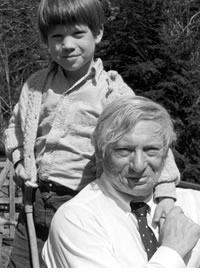 The
week before Nathaniel Kahn will hold a special question-and-answer session
in conjunction with the June 11 screening of his film, My
Architect: A Son’s Journey, at the AIA national convention
in Chicago, he talked with AIArchitect
Executive Editor Douglas E. Gordon, Hon. AIA. Kahn details similarities
between film making and creating a building and describes how his journey
expanded his understanding of his father, his father’s architecture,
and the ability of architecture to make a difference.
The
week before Nathaniel Kahn will hold a special question-and-answer session
in conjunction with the June 11 screening of his film, My
Architect: A Son’s Journey, at the AIA national convention
in Chicago, he talked with AIArchitect
Executive Editor Douglas E. Gordon, Hon. AIA. Kahn details similarities
between film making and creating a building and describes how his journey
expanded his understanding of his father, his father’s architecture,
and the ability of architecture to make a difference.
How did the research you did for this
movie sharpen your appreciation of architecture?
I think that until I picked up a movie camera and tried to capture the
feeling, look, and nature of my father’s buildings, I hadn’t
slowed down enough to figure them out. The analogy that comes to mind
is that architects—wherever they are in the world—want to
draw a building when they see it. I felt the same way about filming the
buildings, in the sense that when you draw something, you’re forced
to slow down and really observe how it’s made, what’s holding
up what, and the proportions. You have to take notice of what makes it
what it is. That same thing is true for me in trying to find ways of filming
my father’s buildings that really captures their essence.
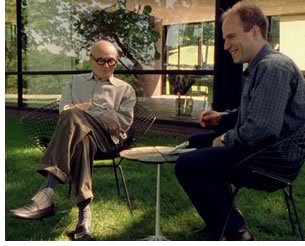 I
wasn’t just interested in how they looked, but also in how they
made me feel. That meant going back to the buildings a number of times
and filming them in different weather conditions and times of day. It
gave me a sense of the concept that architecture lasts a long time and
people don’t. It’s very wonderful that architecture really
is an art that deals with time. A really good building makes you very
aware of time, our own ephemeral-ness and the fact that the things that
we make can last a lot longer.
I
wasn’t just interested in how they looked, but also in how they
made me feel. That meant going back to the buildings a number of times
and filming them in different weather conditions and times of day. It
gave me a sense of the concept that architecture lasts a long time and
people don’t. It’s very wonderful that architecture really
is an art that deals with time. A really good building makes you very
aware of time, our own ephemeral-ness and the fact that the things that
we make can last a lot longer.
The place in history—for instance, Lou’s work in India and Bangladesh—is an idea I had not expected to find. Lou certainly was thought of as an architect in the heroic mode; he was interested in making the world a better place and changing the way we live in and view the world. In some degree, in America, that might have been thought of as being a little bit idealistic. Then to see what Lou was able to achieve in India and Bangladesh—what his architecture is able to do—was astonishing. Somehow, that building and that complex actually did make a difference to those people and did help a fledgling democracy to find its way. It was very moving to me that the building did change the world for those people.
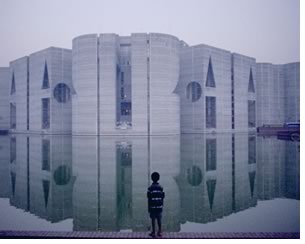 How
did getting an appreciation for your father’s work let you know
the person?
How
did getting an appreciation for your father’s work let you know
the person?
I was surprised at how many different aspects of his personality are in
his buildings. I always knew there was the solemnity, monumentality, and
power—all that stuff I expected to find. But I was surprised to
find other aspects of him—the playfulness, fun, and romanticism.
That was a real joy. I hope that the film helps people see those things
not only in his architecture, but also in the architecture that surrounds
them every day.
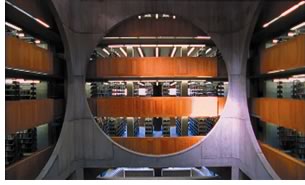 I
made the film not for architects but for the general public. Of course,
I hoped and expected to grab the architecture audience, but I really wanted
to make something that would appeal to a much broader, general audience.
And, of course, the way to do that is to tell a good story and make something
that is emotionally compelling—an emotional story—rather than
something that just engages your intellect.
I
made the film not for architects but for the general public. Of course,
I hoped and expected to grab the architecture audience, but I really wanted
to make something that would appeal to a much broader, general audience.
And, of course, the way to do that is to tell a good story and make something
that is emotionally compelling—an emotional story—rather than
something that just engages your intellect.
The task that I set for myself was to make the architecture emotional and have it be something that would convey the various aspects of the person who created it, and—to go beyond that—be something that talks about architecture and its power in general. That matters a lot to me. I’ve always felt that intuitively, and I’ve certainly been told that by any architect I’d run into. But it wasn’t until I made this film that I really realized it’s true. What architects do really can change the world and make a difference for people. It’s fundamental, just as with that wonderful Churchill quotation: “First we shape our architecture. Thereafter, it shapes us.” I certainly found that in making this film.
 I
know what architects do is a struggle, just like film making. It’s
extremely difficult. Frank Gehry said something really wonderful that
isn’t in the film, but I’ve thought about a lot of times since
then. He said that in making a building, so many things transpire to make
it less than what you dreamed of—whether it’s problems with
money, time, materials, or with people liking it; any number of things.
Yet, sometimes things happen, things get through, and buildings get made.
Films are very much like buildings that way. A lot of things—a lot
of the same things—transpire along the way to make it less than
what you’d hoped. But once in a while, things happen and a really
good thing comes out, and you sense that it is kind of a miracle. Making
this film gave me the sense of how much architects really have to go through
to get something done and how difficult it is. It does make you see a
building—when it really turns out well—as magic.
I
know what architects do is a struggle, just like film making. It’s
extremely difficult. Frank Gehry said something really wonderful that
isn’t in the film, but I’ve thought about a lot of times since
then. He said that in making a building, so many things transpire to make
it less than what you dreamed of—whether it’s problems with
money, time, materials, or with people liking it; any number of things.
Yet, sometimes things happen, things get through, and buildings get made.
Films are very much like buildings that way. A lot of things—a lot
of the same things—transpire along the way to make it less than
what you’d hoped. But once in a while, things happen and a really
good thing comes out, and you sense that it is kind of a miracle. Making
this film gave me the sense of how much architects really have to go through
to get something done and how difficult it is. It does make you see a
building—when it really turns out well—as magic.
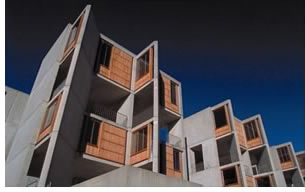 One
of the things that really surprised me about my father, and one of the
areas I’m most happy about in the film, is where we talk about all
the projects he designed that were not built; that symphony of images
that didn’t happen for one reason or another. One of the things
that really gets me about them and endears him enormously to me is how
much he kept at it and wouldn’t give up. If one thing fell through
for him, then, well, he knew something else will come through the next
day. That’s a phenomenal attitude. All of us complain if something
doesn’t work out. I’m sure he did, too, but he wouldn’t
let that get him down for long. That was an aspect of him that I wasn’t
as familiar with, and it was really wonderful to discover.
One
of the things that really surprised me about my father, and one of the
areas I’m most happy about in the film, is where we talk about all
the projects he designed that were not built; that symphony of images
that didn’t happen for one reason or another. One of the things
that really gets me about them and endears him enormously to me is how
much he kept at it and wouldn’t give up. If one thing fell through
for him, then, well, he knew something else will come through the next
day. That’s a phenomenal attitude. All of us complain if something
doesn’t work out. I’m sure he did, too, but he wouldn’t
let that get him down for long. That was an aspect of him that I wasn’t
as familiar with, and it was really wonderful to discover.
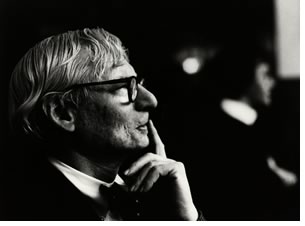 Do
you ever have the experience of looking in the mirror and seeing your
father?
Do
you ever have the experience of looking in the mirror and seeing your
father?
There are certain similarities. Like him, I’m a little slow—things
take me a long time to get done. Aside from that, I hope that I have some
of him in me—he had a lot of amazing qualities. People have said
once in a while that I walk a little bit like him. I like to think of
that, because it must be from inside. He wasn’t around long enough
for me to learn to imitate the way he walked.
If you could ask any questions of your
father now, what would you ask?
I’d hate to disappoint you on this question. But when I started
out on this film, I had many questions. Since making this film, at this
point, I wouldn’t want to ask him any questions. That’s part
of what the film’s process was for me: beginning with so many questions,
ending with many of the same ones, but really wanting to know the guy
and spend some time with him. Sitting in one of those joints in Philadelphia
that he loved so well and sharing a Rolling Rock, which was the beer that
he preferred. Just father to son.
Copyright 2004 The American Institute of Architects.
All rights reserved. Home Page ![]()
![]()
 |
||
| For more
information about the screening of My Architect at the AIA Convention
in Chicago June 10, 7–10:30 p.m. at the Adler Sullivan-designed
Auditorium Theatre, go to the AIA Convention site. You will see a convention registration icon in the upper right-hand corner of that page through which you can also register for tickets to the screening. If you are already registered for the convention, you can go to your personal URL, which came with your registration confirmation, and add ticket E51 to your itinerary. Tickets will also be available June 8–10 at the AIA Bookstore and Convention Registration booth on site at Chicago’s McCormick Place. Click here for the AIArchitect review of My Architect. Metropolis magazine
also interviewed Nathaniel Kahn for its June 2003 issue. And there is a My Architect Web site.
|
||